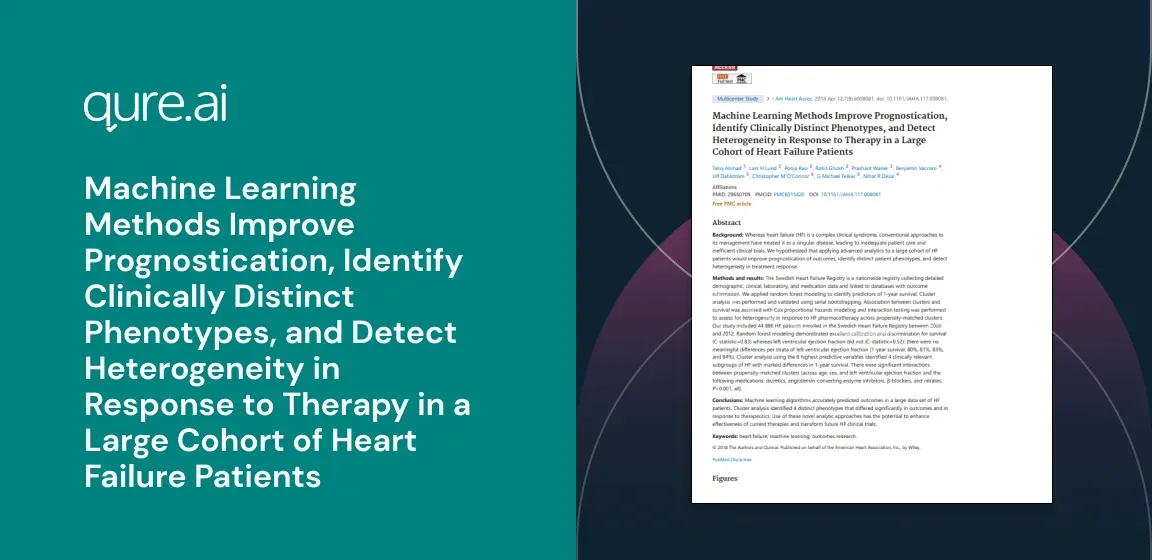Background
Published 11 Apr 2018
Machine Learning Methods Improve Prognostication, Identify Clinically Distinct Phenotypes, and Detect Heterogeneity in Response to Therapy in a Large Cohort of Heart Failure Patients
Author: Tariq Ahmad 1, Lars H. Lund 2, Pooja Rao 3, Rohit Ghosh 3, Prashant Warier 3, Benjamin Vaccaro 1, Ulf Dahlström 4, Christopher M. O'Connor 5, G. Michael Felker 5, Nihar R. Desai 11

Back
Whereas heart failure (HF) is a complex clinical syndrome, conventional approaches to its management have treated it as a singular disease, leading to inadequate patient care and inefficient clinical trials. We hypothesized that applying advanced analytics to a large cohort of HF patients would improve prognostication of outcomes, identify distinct patient phenotypes, and detect heterogeneity in treatment response.
Methods and Results
The Swedish Heart Failure Registry is a nationwide registry collecting detailed demographic, clinical, laboratory, and medication data and linked to databases with outcome information. We applied random forest modeling to identify predictors of 1‐year survival. Cluster analysis was performed and validated using serial bootstrapping. Association between clusters and survival was assessed with Cox proportional hazards modeling and interaction testing was performed to assess for heterogeneity in response to HF pharmacotherapy across propensity‐matched clusters. Our study included 44 886 HF patients enrolled in the Swedish Heart Failure Registry between 2000 and 2012. Random forest modeling demonstrated excellent calibration and discrimination for survival (C‐statistic=0.83) whereas left ventricular ejection fraction did not (C‐statistic=0.52): there were no meaningful differences per strata of left ventricular ejection fraction (1‐year survival: 80%, 81%, 83%, and 84%). Cluster analysis using the 8 highest predictive variables identified 4 clinically relevant subgroups of HF with marked differences in 1‐year survival. There were significant interactions between propensity‐matched clusters (across age, sex, and left ventricular ejection fraction and the following medications: diuretics, angiotensin‐converting enzyme inhibitors, β‐blockers, and nitrates, P < 0.001, all).
Conclusions
Machine learning algorithms accurately predicted outcomes in a large data set of HF patients. Cluster analysis identified 4 distinct phenotypes that differed significantly in outcomes and in response to therapeutics. Use of these novel analytic approaches has the potential to enhance effectiveness of current therapies and transform future HF clinical trials.
Authors
Tariq Ahmad 1, Lars H. Lund 2, Pooja Rao 3, Rohit Ghosh 3, Prashant Warier 3, Benjamin Vaccaro 1, Ulf Dahlström 4, Christopher M. O'Connor 5, G. Michael Felker 5, Nihar R. Desai 11
Citation
1. Section of Cardiovascular Medicine and Center for Outcomes Research 2. Yale University School of Medicine New Haven 3. CT 4. Department of Cardiology 5. Karolinska Institutet Department of Medicine and Karolinska University Hospital 6. Stockholm 7. Sweden 8. Qure.ai 9. Mumbai 10. India 11. Department of Medicine and Health Sciences 12. Linköping University 13. Linköping 14. Sweden 15. Duke Clinical Research Institute 16. Duke University 17. Durham 18. NC